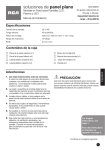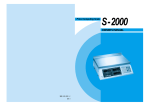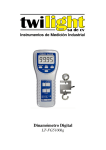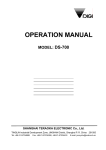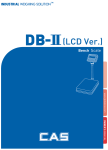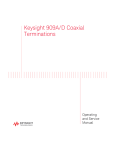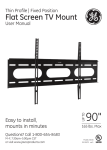Download RCA MST46BKR User's Manual
Transcript
flat panel solutions Tilt Wall Mount for LCD, Plasma, and LED Displays MST46BKR Fits TVs 26”- 46” Maximum Load Capacity – 99 lb (45 kg) Instruction Manual Specifications Display Size: 26” to 46” Maximum Load: 99lb (45kg) Mounting Pattern: 400 mm x 400 mm (15.7” x 15.7”) max Tilt Range: 15° down Profile: 1.4” (3.5cm) Box contents Upper Wall Plate (x1) Mount Arm (x2) Lower Wall Plate (x1) Instruction Manual (x1) Left Plastic Side (x1) Hardware Kit (x1) Right Plastic Side (x1) Template (x1) Warnings 1. Read these instructions before you begin. If you are unsure of any part of the process, contact a professional contractor or installer for assistance. Improper installation can result in injury or damage. 2. The wall or mounting surface must be capable of supporting the combined weight of the mount and the display; if not, the structure must be reinforced. CAUTION: This wall mount is intended for use only with the maximum weight of 45 kg/99 lbs. Use with heavier than the maximum weights indicated may result in instability causing possible injury. 3. Locate pipes, wires, or any other hazards in the wall where you wish to install the mount before drilling. 4. Safety gear and proper tools must be used. Failure to do so can result in injury or damage. 5. A minimum of two people are required for installation. Do not attempt to install this mount alone under any circumstances. 6. Follow all instructions and recommendations regarding adequate ventilation and suitable locations for mounting your display. Consult the owner‘s manual for your particular display for more information. Pour des instructions en français, se reporter à la page 6. Para obtener instrucciones en español, consulte la página 11. Continues on next page... Tools required Phillips-Head Screwdriver or Screw Gun Electric or Portable Drill 3 mm (1/8”) Drill Bit and Stud Finder for Drywall Installation 8 mm (5/16”) Masonry Bit for Concrete Installation Level Hardware kit (A) M6.3 x 63 Lag Bolt (x4) (H) M8 x 12 Screw (x4) (B) Washer (x4) (I) M8 x 30 Screw (x4) (C) Concrete Anchor (x4) (J) M6 Washer (x4) (D) M4 x 12 Screw (x4) (K) Spacer (x8) (E) M4 x 20 Screw (x4) (L) Long Allen Key (x1) (F) M6 x 12 Screw (x4) (M) 3/16” Drill Bit (G) M6 x 30 Screw (x4) Assembly Assemble the mount by carefully snapping the right and left plastic sides onto the upper and lower wall plates, as shown in the illustration (see Fig. 1). Do not force any of the connections as it may result in breakage of the plastic parts. Fig.1 Installation Part 1A – Mounting to the Wall (Drywall) IMPORTANT! For safety reasons, this mount must be secured to at least two wood studs no less than 16” apart. The studs must be capable of supporting the combined weight of the mount and display. 1. Use a high quality stud finder to locate two adjacent studs where you wish to install your mount. Mark both edges of each stud to help identify the exact center. NOTE: You must use the center of each stud to avoid cracking or splitting the wood during installation. 2. Place the mounting template against the wall over the center line of the marked studs. Make sure the template is level. 3. Drill four 3 mm (1/8”) pilot holes in the wall using the template as a guide. Drill two holes per stud (see Fig. 2). 4. Remove the template from the wall and place the assembled wall plate against the wall over the pilot holes. 2 Fig.2 5. Attach the wall plate to the wall using the M6.3 x 63 screws (A) and washers (B) English provided (see Fig. 3). Do not over-tighten these screws and do not release the mount until all screws are in place. Ensure that the mount remains level after all screws are secured. Fig.3 Part 1B – Mounting to the Wall (Concrete) IMPORTANT! For safety reasons, the concrete wall must be capable of supporting the combined weight of the mount and the display. The manufacturer takes no responsibility for failure caused by walls of insufficient strength. 1. Place the mounting template against the wall in the desired location. Make sure the template is level. 2. Drill four 8 mm (5/16”) holes in the wall using the template as a guide. Remove any excess dust from the holes. (see Fig. 4). Fig.4 3. Remove the template from the wall and insert a concrete anchor (C) into each hole so that it is flush with the concrete surface (see Fig. 5). A hammer can be used to lightly tap the anchors into place if necessary. NOTE: If the concrete wall is covered by a layer of plaster or drywall, the concrete anchor must pass completely through the layer to rest flush with the concrete surface. 4. Place the assembled wall plate against the wall over the inserted anchors and attach it using the M6.3 x 63 screws (A) and washers (B) provided (see Fig. 3). Do not over-tighten these screws and do not release the mount until all screws are in place. Ensure that the mount remains level after all screws are secured. Fig.5 Part 2 – Attaching the Mount Arms to the Display IMPORTANT! Use extra care during this part of the installation. If possible, avoid placing your display facedown as it may damage the viewing surface. NOTE: This mount comes with a selection of different screw diameters and lengths to accommodate a wide variety of display models. Not all of the hardware in the kit will be used. If you cannot find the appropriate screw size in the kit provided, consult the manufacturer of your display for more information. 1. Determine the correct length of screw to use by examining the back of your display: A. If the back of your display is flat and the mounting holes are flush with the surface, you will use the shorter screws (D, F or H) from the hardware kit. B. If the back of your display is curved, has a protrusion, or if the mounting holes are recessed, you will need to use the longer screws (E, G or I) and may also need to use the spacers (K). 2. Determine the correct diameter of screw to use by carefully trying one of each size (M4, M6 and M8) from the hardware kit. Do not force any of the screws – if you feel resistance stop immediately and try a smaller diameter screw. Continues on next page... 3 3. Attach the mount arms to the back of your display using the screws identified in steps 1 and 2 (see Fig. 6): For displays with flat backs. For displays with curved or recessed backs. Fig.6 A. If you are using the M4 or M6 screws you will also need to use the M6 washers (J). M8 screws do not require washers. B. If you are using the longer screws on a display with a curved or recessed back, you may also need to use the spacers (K). Use one spacer or two spacers stacked as needed. Only use a spacer if necessary. NOTE: Make sure the mount arms are attached with the tilt mechanisms facing outward, exactly as shown in the illustration (see Fig. 7). Otherwise, the tilt function cannot be accessed. Tilt Adjustment Mechanism Tilt Adjustment Mechanism Fig.7 Part 3 – Final Assembly 1. Check to make sure the tilt mechanism is fully tightened. It can be tightened using the long Allen key (L) provided in the hardware kit. 2. With the help of another person, carefully lift your display and place it on the mount. Do not release the display until the mount arms have securely hooked onto the mount. 3. Make sure the safety locks have successfully engaged by gently pushing up on the display. You should not be able to remove the display from the mount. 4. If the plastic tabs hang below the bottom of your display they can be trimmed with a knife or looped back and tucked into the rubber ring located on each tab. 5. If you need to remove the display from the mount, pull the plastic tabs located at the bottom of the mount arms down and then forward (away from the wall) to engage the tooth and disengage the safety locks (see Fig. 8). With the help of another person, carefully lift the display from the mount. Return the tabs to their original position by pulling them down and pushing them backwards. 4 1 Fig.8 2 Operation and adjustment 1. To change the tilt angle of your display, hold the display firmly in place and English loosen the tilt mechanisms using the long Allen key (L) from the hardware kit (see Fig. 9). Move your display to the desired position, and then re-tighten the tilt mechanisms. If your display is in the non-tilt position, you will need to push up gently on the display before you can move it. Do not release the display until both tilt mechanisms are firmly tightened. 2. Periodically clean your mount with a dry cloth. Inspect all screws and hardware at regular intervals to ensure that no connections have become loose over time. Fig.9 Re-tighten as needed. 5





